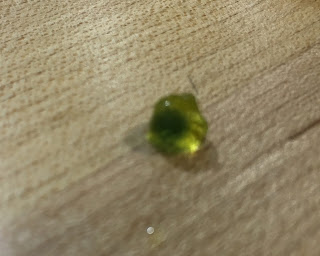Week 5: Alginate creation
This week, the group moved forward with our new project idea. Besides refining the concept, the group made their first attempt at creating multilayered hydrogels. Figures 1 and 2 show multilayered hydrogels at 1 wt% and 1.5 wt% alginate, respectively. Two distinguish between layers, contrasting food dyes were mixed with individual batches of sodium alginate solution. The inner core was created by injecting ≈ 0.5 mL of sodium 1 wt% sodium alginate into a 1 wt% CaCl2 solution, forming a 4mm diameter sphere. Subsequent layers were formed by dipping the cores in an alginate solution dyed a different color followed by the CaCl2 bath. Preliminary findings found a positive correlation between dipping time and layer thickness up to a 3mm maximum.
Upon another meeting with the group advisor, it was determined that the project was a sound one but could use some simplification. After further discussion, the group came to the conclusion that it was best to simply make an alginate bead with bromelain that would release in the stomach over time, removing the outer layer of calcium carbonate that would act as an antacid. All this would require would be creating a dense bead of alginate mixed with bromelain that would be ingested by the patient.
Upon another meeting with the group advisor, it was determined that the project was a sound one but could use some simplification. After further discussion, the group came to the conclusion that it was best to simply make an alginate bead with bromelain that would release in the stomach over time, removing the outer layer of calcium carbonate that would act as an antacid. All this would require would be creating a dense bead of alginate mixed with bromelain that would be ingested by the patient.
 |
| Figure 1. 1% Calcium Alginate Hydrogel Bead |
 |
| Figure 2. 1.5% Calcium Alginate Hydrogel Bead |
I recently came across your blog and have been reading along. I thought I would leave my first comment. I don't know what to say except that I have enjoyed reading. Nice blog. I will keep visiting this blog very often. alginate
ReplyDelete